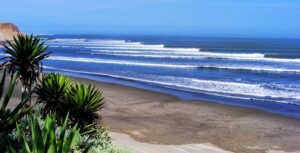Winter is over! Not really…
SURF:
With a week left of winter, sure seems like it left in a hurry with 75 degree air temps at the beach today. Lots of good leftover NW groundswell today too with a touch of SW AND offshore winds before lunch- sure made it fun from southern SD to northern OC. Tomorrow the NW backs off while the waist high+ SW holds, then mainly small SW on Saturday, then a touch more NW/SW on Sunday for inconsistent chest high sets. In summary, a couple small swells from the SW/NW this weekend and great weather again. And here’s some numbers to crunch:
Water temps are 58 degrees.
Tides this weekend are:
- 5.5′ at sunrise
- -0.5′ at lunch
- 4.0′ at sunset
Daylight hours this weekend are:
- 7 AM sunrise
- 7 PM sunset
For a more detailed THE Surf Report, check out http://northcountysurf.blogspot.com/.
FORECAST:
The work & school week starts off with small leftover SW/NW for a continuation of waist to chest high surf, then we get a bump from the SW on Tuesday for better chest high SW. On Wednesday, the WNW picks up to the overhead range BUT… it’s due to a storm bearing down on us. Typical. Shouldn’t be a big rainmaker but just enough to mess up the solid surf. Late next week the NW/SW backs off but models show more overhead W swell next Sunday. And hopefully no rain. And if the forecast charts are right, the southern hemisphere finally kicks into gear and we get fun chest high+ SW around the 27th and shoulder high+ around the 29th. Make sure to keep track of the waves and weather at http://twitter.com/NorthCountySurf.
WEATHER:
Great summer-like weather today with temps in the mid-70’s, offshore winds, and sunny skies. That will last through the weekend with temps reaching the high 70’s and offshore winds in the AM. Low clouds should return early next week as high pressure backs off and the storm mentioned above moves into Southern California on Wednesday. Not looking like a big storm but definitely a last gasp for winter. After Thursday, we should get a couple cool days late in the week as the storm exits the region.
BEST BET:
Tuesday with new SW late in the day and hopefully some of that new NW before the storm moves in on Wednesday.
NEWS OF THE WEEK:
There are 2 things I’m not a fan of along our coast- Great Whites and sea urchins. Actually, make that 3 things- crowds in the line up too. Oh- and south winds. So that’s 4 things I don’t like. And seagulls stealing my lunch! That’s 5 I guess. Ok- I’m getting off track here. Let’s get back to sea urchins. They’re pretty to look at from a distance, but up close- ouch! Stepping on one is as painful as a sting ray (so I guess sting rays are 6th on my growing list). As well as being landmines as you walk into the surf, sea urchins also destroy our kelp beds which help negate wind chop on the surf. The main predator of sea urchins, the sea otter, have been in decline but our kelp forests in Southern California have maintained their growth somehow. So what is keeping the sea urchins in check? A new study by San Diego State University (the university that produced such luminaries as Gregory Peck, Tony Gwynn, Raquel Welch, Kawhi Leonard, Mrs. Cunningham from Happy Days, and Michael W. Glenn among others) have found our heroes:
California sheephead and spiny lobsters may be helping control sea urchin populations in Southern California kelp forests, where sea otters — a top urchin predator — have long been missing, according to a new study published in the journal Ecology. The research provides new insight into the complex predator-prey relationships in kelp forests that can be seen in the absence of sea otters. The study is also the first to experimentally test the relative impact, or rate of feeding, of the California sheephead and spiny lobsters in comparison to sea otters, whose historical range spanned from British Columbia, Canada to Baja California, Mexico.
“Healthy kelp forests are important both economically and ecologically along our coast. They act as nurseries and vital habitat for valuable fishery species, recreation sites for kayakers, free divers, and scuba divers, and serve as the base of rocky reef food webs,” says Robert Dunn, who led the study as a Ph.D. candidate at SDSU and University of California, Davis, funded by a NMFS-California Sea Grant Fellowship.
Kelp forests rely on the proper balance of herbivory and predation. Sea urchins dwell on the seafloor where they forage on macroalgae, including giant kelp. If their populations are left unchecked by predation, they can decimate kelp forests and prevent kelp from growing. That can transform a thriving community of kelp into an oceanic desert, known as an urchin barren. The relationships between predators and prey vary among communities. Sea urchins have recently decimated kelp forests in Northern California, leaving researchers to wonder why Southern California kelp forests have remained relatively intact without sea otters to control the urchin populations.
Past research has indicated that Marine Protected Areas in Southern California house a diversity of predators — warranting fewer urchins and abundant kelp. Dunn and his SDSU graduate advisor, Kevin Hovel, set out to better understand the potential for top-down control by these two distinct predators: the California sheephead and spiny lobsters. “One of the main things to note about Robert’s research is that he was able to experimentally control, for one of the first times, many factors that allow us to test whether or not these predators have the right amount of influence, whether they can eat fast enough, and if there are enough of these predators within the ecosystem to exert strong influences on sea urchins,” says Hovel, a professor of biology at the Coastal and Marine Institute at SDSU.
The new findings are in line with concurrent international research. Dunn said another recent study in southern Australia “found comparable results that predators and disease seem to be able to control urchins up to a certain density, similar to the number we found, but once urchins get to really high densities, those two factors no longer regulate urchin populations. Since our results are in line with findings on other rocky reefs, we believe this to be solid evidence indicating our results are robust.”
The new research provides valuable information to understand and protect California’s quintessential kelp forests. The researchers note, however, that further research is needed to tease out the complex relationships between sea urchins and their predators. “These results shed light on a very nuanced relationship, that requires further research on rocky reefs around the globe,” says Dunn. “At the same time, we are already experiencing effects from global climate change, which will have additional consequences for these important ecosystems.”
PIC OF THE WEEK:
Sure this wave is amazing, but if you lived here, would you want to go right once in awhile?…
Keep Surfing,
Michael W. Glenn
Just Discovered I Have X-Ray Vision
Paid $500,000 For My Son’s Scholarship To The University of Mossimo
Nobel Laureate For Surfology

